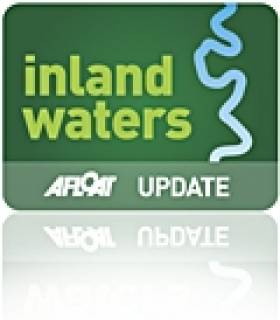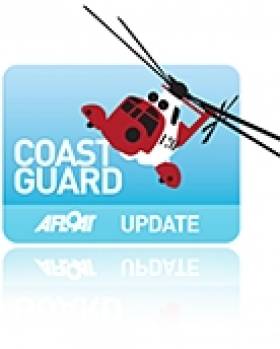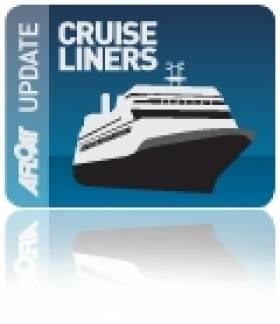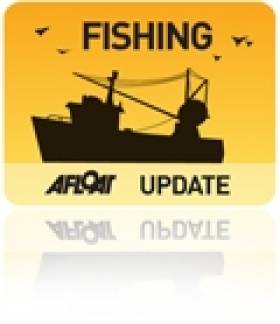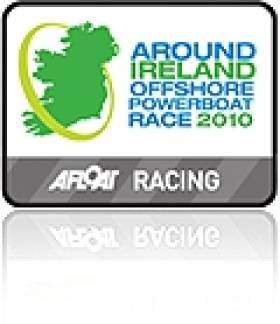Displaying items by tag: Killybegs
Donegal Fishing Boat Firm Tops List of Tax Defaulters
#FISHING - A Donegal firm that leases fishing boats has reached a settlement of €3.39 million with the Revenue Commissioners over its failure to declare taxes, The Irish Times reports.
The settlement by O’Shea Fishing Ltd in Killybegs, which arises from the undeclaration of corporation tax, PRSI, and PAYE, is the largest on the quarterly list of tax defaulters published by Revenue earlier this week.
Second on the list is the settlement for €2.133 million for undeclared VAT on apartment sales by the construction firm owned by independent TD Mick Wallace.
The Irish Times has more on the story HERE.
Massive Fee Increases Proposed for Harbour Yacht Berths
#IRISH HARBOURS - Yachts berthing at Ireland's main fishing harbours could see their charges hiked by an incredible 800 per cent.
According to The Irish Times, Marine Minister Simon Coveney has announced a mere 21 days for comment and consultation on the draft Fishery Harbour Centres (Rates and Charges) Order 2012. The consultation document is attached to the bottom of this post and available to download as a pdf.
The proposed new charges include an annual fee of €250 per metre for yachts, which could see a 10-metre yacht currently paying €312 a year for a berth shell out as much as €2,500 annually for the same space.
Additional water and electricity costs could even see this bill rise to €3,100 - for berths that come "without proper marina facilities in most cases".
The proposals apply to the State's six fishery centres at Killybegs, Rossaveal, Dingle, Castletownbere, Dunmore East and Howth, only two of which have pontoons suitable for leisure boats.
The Irish Times has more on the story HERE.
New Tug for Shannon-Erne Waterway
#INLAND WATERWAYS - Waterways Ireland has taken delivery of its third tug boat from Mooney Boats of Killybegs.
Designed by Marine Design International, the Inish Fendra is an 11.2-metre LOA steel-built tug which has been specifically tailored for operation on the Shannon-Erne waterway system.
Its design bears many similarities to the Inis Muillin, which was delivered by Mooney Boats in 2010.
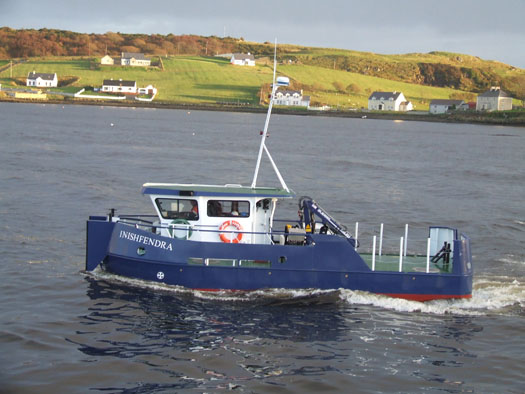
The new tug, Inisfendra built by Mooney Boats of Donegal
According to Maritime Journal, the design process "involved significant input from the vessel operators and managers combined with the latest technology and ideas from the designers and builders to improve on efficiency" and safety.
A key feature of the Inish Fendra is its 3,500-litre ballast tank and pumping system, which is operated by the push of a button and can reduce the vessel's air draft by 0.2m.
Maritime Journal has much more on the Inish Fendra HERE.
Go-Ahead for Killybegs Coastguard Station
#COASTGUARD - The Office of Public Works has given the go-ahead to a long-awaited new coastguard station for Killybegs, the Donegal Democrat reports.
The multi-million-euro three-storey station - replacing the current 20-year-old building, which is deemed no longer suitable to demands - will be constructed at the Rough Point and will include a boat house and pollution control centre.
The Irish Coast Guard unit at Killybegs has 25 volunteer members, and also operates as a mountain and cliff rescue service. The unit serves one of Ireland's busiest ports.
The Donegal Democrat has more on the story HERE.
Killybegs Report Shows Maritime Jobs Potential
#JOBS – 250 jobs could be created over a three year period across five key maritime areas in Killybegs according to a report launched by the Minister for Agriculture, Food and the Marine, Simon Coveney TD,
Minister Coveney set up the group on the 3rd June this year following the Economic Report for the European Commission, which assessed the status, development and potential diversification of Killybegs as a fisheries dependent community. The Group comprising of representatives from the Irish seafood sector, tourism, education, enterprise and the Department of Agriculture, Food and the Marine were tasked to identify potential jobs across key areas including seafood, ancillary services, offshore supports, tourism and marine leisure and green economy/renewable energy.
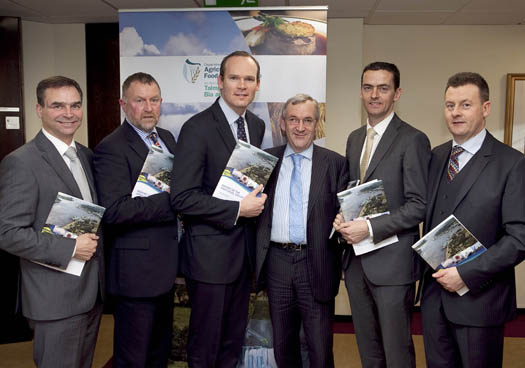
Minister for Agriculture, Food and the Marine, Simon Coveney with Sean O'Donoghue, Chairman, Chief Executive, Killybegs Fishermen's Organisation Ltd, Cecil Beamish, Assistant Secretary, Department of Agriculture, Food and the Marine, Seamus Neely, County Manager, Donegal County Council, Jason Whooley, Chief Executive, Bord Iascaigh Mhara (BIM), Paul Hannigan, President, Letterkenny Institute of Education, Jim Parkinson, Representing Offshore and Ancillary Services, Niall O'Gorman, Representing Donegal Fish Merchants Association and Conor Fahy, Regional Director, Enterprise Ireland at the launch of a report on Job Creation in the Killybegs Region.
Minister Coveney commented at the launch; "I set ambitious targets for the group and I am very pleased to see that the group has not only clearly outlined how 250 jobs can be achieved but has also identified new areas where additional jobs can be created into the future. The importance of the seafood sector to Killybegs region cannot be overstated as it is responsible for 68% of the workforce. The Group has identified that through greater diversification and adding value to our existing resources, 130 jobs will be delivered in this sector. The Group are to be commended for working together to complete this task in the allocated time and I am looking forward to seeing the actions from the report completed and the benefits that they will bring to the people of Killybegs".
The report outlines 250 jobs to be created over a three year period across five key areas. In total, 130 potential jobs were identified within the seafood sector. The expected increased access to raw materials such as blue whiting and boarfish present the most significant opportunities, along with a concerted focus on value adding opportunities. Within the ancillary services, 24 jobs were identified if collaborative opportunities between various companies can be enhanced and their abilities promoted. The offshore sector could generate 20 jobs, however competitive service provision and appropriate skill resources are deemed fundamental to achieve this. Approaching 50 jobs were identified within the tourism/marine leisure area if a co-ordinated marketing strategy is developed, whilst the green economy and renewable energy area offers the potential to create up to 40 jobs.
The Minister added "This pilot approach of co-ordinated developmentally focused activity which is concentrated on natural resources has delivered results that will drive economic development and job creation in the Killybegs region. An example of this is the partnership between BIM and LYIT to address seafood value added activities. As a direct result of this jobs initiative, the College of Catering in Killybegs will become a focus for industry activity beginning with a workshop on new product development for crab suppliers is already planned for the 30th November".
Members of the High Level Group are:
Sean O'Donoghue, Chairman, Chief Executive, Killybegs Fishermen's Organisation Ltd
Cecil Beamish, Assistant Secretary, Department of Agriculture, Food and Marine
Seamus Neely, County Manager, Donegal County Council
Jason Whooley, Chief Executive, Bord Iascaigh Mhara (BIM)
Paul Hannigan, President, Letterkenny Institute of Education
Jim Parkinson, Representing Offshore and Ancillary Services
Niall O'Gorman, Representing Donegal Fish Merchants Association
Conor Fahy, Regional Director, Enterprise Ireland
Small Luxury Cruiseship Visits Killybegs
In 2004 Killybegs received a significant boost in the completion of a €50m outer harbour with berthing quays totalling 350-metres long so to accommodate the north-west fleet and to include the 'supertrawlers'.
Despite the major port infrastructural investment, Killybegs has seen declining fortunes in the fish industry though in recent year's new business from the offshore exploration and cruise ship industries has assisted in generating new revenue.
The near 700-passenger capacity ship operated by UK based Voyages of Discovery is scheduled to call at several Scotish ports before returning to Portsmouth via the North Sea.
Discovery has eight decks with facilities to include two swimming pools, one with a retractable roof, jacuzzis, lounges, bars, a library and gymnasium, lecture theatre, cinema, restaurants, an internet cafe, shop, beauty salon and a medical centre.
She was built in 1971 as the Island Venture, then renamed Island Princess after purchased by Princess Cruises, alongside her sister Pacific Princess which appeared in the popular US TV series sitcom the 'Love Boat' broadcast by ABC between 1977-1986.
In total there will be four cruise-calls during the season to Douglas but the next visit will be not until July when P&O Cruises Adonia calls on the 17th. The ten-year old 710 passenger vessel is due to be named by Dame Shirley Bassey at a ceremony held in Southampton later this month.
Also calling to Douglas will be Oceania Cruises brand new 60,000 tonnes / 1,250 passenger Marina on the 24th July and the final call is to be made by Noble Caledonia's Japanese built Clipper Odyssey in mid-August.
- Killybegs
- Cork
- Discovery
- Marina
- Ringaskiddy
- Cruise Liners
- Princess Cruises
- southampton
- Isle of Man
- P&O Cruises
- Ports and Shipping News
- Manx
- Voyages of Discovery
- Douglas
- Douglas Bay
- Adonia
- Dame Shirley Bassey
- The 'Love Boat'
- ABC
- Pacific Princess
- Island Princess
- Oceania Cruises
- Cruise Liner news
- Clipper Oydessey
- Noble Caledonia
Mr. Sean Connick, T.D. Minister of State at the Department of Agriculture, Fisheries and Food welcomed the agreement reached after two days of talks in Brussels on 2011 quotas for the Irish fishing fleet.
The final agreement will deliver whitefish quotas worth some €116 million, including the protection of Ireland's €54 million prawn fishery. There will be a 10% increase in quota for Ireland's €75 million mackerel industry and a two thirds share, worth approximately €4 million, for Irish fishermen of the new boarfish industry.
Speaking at the end of the negotiations in the early hours of Wednesday (16 December), the Minister said
"The negotiations have been particularly challenging this year with the European Commission proposing cuts across many stocks of commercial importance for Ireland. Consulting with our fishing industry and NGOs, working with other Member States and concentrating on the scientific evidence, was, I believe key to securing a balanced sustainable package."
"This package will help underpin the economic future of our costal communities."
There will be 15% increase in haddock and whiting stocks in the Celtic Sea. While for the cod stocks off the North West and the Irish Sea, the quotas will be reduced by 25% in line with the Recovery Plan for these stocks. For Celtic Sea cod, the current quota level has been maintained for 2011 on the basis of new survey results from the State's Research Vessel "Celtic Explorer".
Minister Connick commented "By introducing new information on Celtic Sea cod, I secured agreement that the current level of TAC will continue into 2011, and may be increased during the year if the new survey results are confirmed by the scientists. However, given the poor state of cod stocks off the North West and in the Irish Sea, cuts were necessary".
Commenting on the 3% reduction in the prawn quota, the Minister said "Prawns are a very important fishery all around our coast. It is the most valuable catch for the Irish whitefish fleet worth €54 million. While the Commission originally proposed a 17% cut, I secured just a 3% decrease in the quota on the basis of a strong scientific case."
The quota for mackerel will be increased by 10%, and should be worth up to €75m in 2011. This is the most important fishery for the North West fleet based in Killybegs and is also important for the South West multi purpose fleet, supporting processing jobs in the coastal communities.
There were also increases in the quota for Celtic Sea herring of 30%, although there were cuts in the North West stock reflecting concerns about the state of those stocks.
Finally, Ireland secured the largest share in an important new fishery for boarfish that will be worth just under €4 million in 2011. The Irish fishing industry has been working with the scientific community to develop a management plan for boarfish, a mid-water shoaling species, now found in large volumes off the South West coast. The agreement reached in Brussels provides for a total allowable catch of some 33,000 tonnes, with two thirds going to Ireland.
Minister Connick commented "In an example of a successful investment in scientific research by industry, we have opened up a new fishery and secured the major stake in that industry. This ensures a new revenue stream for Irish industry into the future. We believe we can now develop a significant and sustainable fishery on this stock, in which we will continue to hold the largest share".
Here is the tracker link to follow the Around Ireland Powerboat Challenge. Click here. The boats are now in Killybegs after the first leg of the five day voyage from Galway.




























